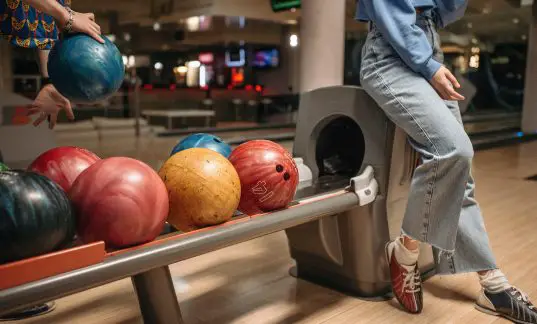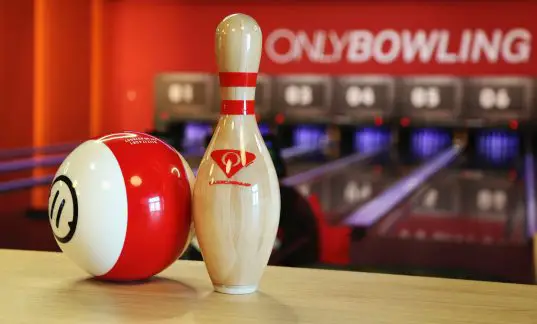Are you ready to invest in your bowling ball? Are you worried about how long your new ball will last, even with proper care and proper maintenance?
While a few frames won’t cause much of a problem for your ball’s cover stock, repeated use without a smart coverstock maintenance routine is a bad idea.
Professional bowlers know the value of maintaining both your strike ball and your spare ball, and you should too! If you’re going to be using the same ball over and over again, it’s good practice to clean it and remove potential problems such as excess oil, dirt, and dust.
We’ve created this guide about the life of bowling balls to help your get more from your ball when you bowl. With the help of common cleaning agents such as rubbing alcohol, Simple Green, and a microfiber towel, you can extend your ball’s life for countless games to come.
How long does a bowling ball last?
How long does a reactive resin bowling ball’s surface last?
The average reactive bowling ball, stored at room temperature and cleaned regularly, offers around 5-10 years worth of usage life. That’s about 150-300 games on average before the reactivity starts to wane considerably. The more oil your reactive resin ball absorbs and the less you clean it, the shorter its life span will be.
How long does the surface of a plastic ball last?
While plastic bowling balls do not absorb oil like their reactive counterparts, they wear down in different ways with regular play. Oftentimes, the core configurations for cheaper plastic balls have shorter usage lives. If you hear a hollow sound or a rattling when the ball hits the pins, you’re likely dealing with a separated core. In addition, cracking is common for older plastic balls near the finger holes.
A good plastic ball can last you 5-10 years or more, depending on regular maintenance and your throwing habits.
How do lane conditions at your local bowling alley affect the life of a new ball?
Greatly! Your equipment is only as good as its environment and the conditions it’s forced to contend with. If you throw your ball consistently at an alley that is poorly maintained, each shot puts your ball’s usage life in peril. If your alley’s operator fails to properly oil the back end of their lanes as the day goes on, your ball might run into some issues with depleted conditions that could cause cracking or fissures in the future.
How do you know when to replace your own bowling ball?
Is your grip starting to fail? Is your bowling ball’s initial reactivity muted to the point of being barely recognizable? Have you completed a full resurface of your ball to almost no effect? If you’ve properly maintained your ball and are still running into myriad issues playing with it, you should consider replacing it. And if the ball is cracked, warped, or suffering from a core separation, you should weigh your options — sometimes paying to fix a ball just isn’t worth it. Sometimes that money is better spent on a new ball.
However, that doesn’t mean you should give up on your old ball…
Your bowling ball can last longer! Here’s how.
How do you make a new bowling ball last longer?
Invest in a microfiber cloth and wipe your ball down completely between throws. Removing excess oil, dirt, and grime is essential to promoting your coverstock’s health for plenty of games to come. There are also an array of bowling-specific cleaners that you can use to clean your ball once a week or so. If you don’t want to invest in a name-brand cleaner, a concoction of equal parts water, Simple Green, and rubbing alcohol will work just as well.
In addition, be sure to rotate your ball every week and store it at room temperature. Ambient temperatures that are too hot or too cold can damage your ball’s coverstock and decrease its playing life.
How do you rejuvenate old bowling balls for extended use?
It depends on the issues you’re dealing with. The regular maintenance we prescribed for a new bowling ball works just as well for older bowling balls, as well. However, you’re going to need to be much more careful with an older ball. If the coverstock is starting to fail, consider rebuffing it closer to the original factory finish and having it fully resurfaced. Ask your local pro shop owner for tips about your specific ball, and be sure to clean it regularly after use.
You can also have them bake your ball safely to remove excess oil or learn how to do it safely at home in your dishwasher.
Should you take your reactive ball to a local pro shop or clean it yourself?
If you’re looking to maintain a reactive resin bowling ball for years of use, you’ve gotta clean it shot after shot, game after game. Proper care during use is critical to extending its life. However, there are some maintenance issues for everything from finger inserts to coverstocks that might be worth calling a pro shop for. You can maintain a reactive ball on your own, DIY-style. But, calling in a professional (regardless of your bowling skill level and knowledge base) is sometimes preferable — especially if you don’t have the equipment they do for rejuvenating bowling balls for countless others in the community.
Frequently Asked Questions
How often should you clean most bowling balls?
According to most bowling ball manufacturers and most expert bowlers around the world, you should clean your bowling ball thoroughly about every six games. That doesn’t include wiping down your bowling ball with a microfiber towel after every shot and storing it properly between games. A full cleanse should be performed every six games, and normal maintenance techniques should be employed in the interim.
How does oil absorption affect your entire ball?
Oil absorption is a catch-22 for reactive resin bowling balls. While the absorption of oil is crucial for the reactivity of a reactive coverstock, it’s also one of the main culprits that will decrease a ball’s usage life. The longer that oil is left deep in the pores of a ball, the gummier things get. And as things start to gum up, the reactivity of your ball starts to drop. That’s why it is crucial to constantly maintain your ball and clean it regularly.
How is your ball’s life affected by a long bowling session?
It depends on how well you maintain the ball between shots. If you’re wiping off extra oil, dirt, and detritus from your ball between shots, it won’t be affected nearly as much as if you weren’t performing these regular maintenance tasks. If you bowl six games or more with a ball in a single session, be sure to clean it as soon as you can. Take a close look at your coverstock and listen to the way your ball hits the pins late in your session. If something seems amiss, take your ball to the local pro shop or do your best to perform DIY maintenance at home.
Closing Thoughts
The reaction capabilities of your new bowling ball need constant maintenance. Without taking steps to reduce oil absorption and environmental hazards such as extreme cold, your return on investment is going to be much less than it could be. Talk to workers at local pro shops, safeguard your ball at the lanes, and clean it regularly to ensure it gives you the time and performance you paid for.

